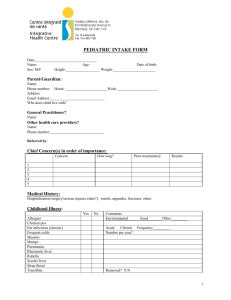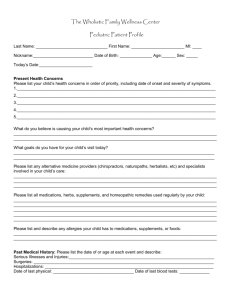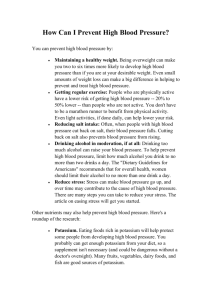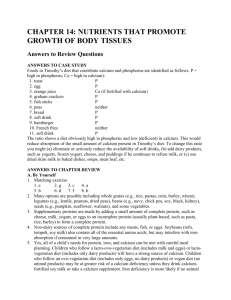Eat right for every stage of life
advertisement
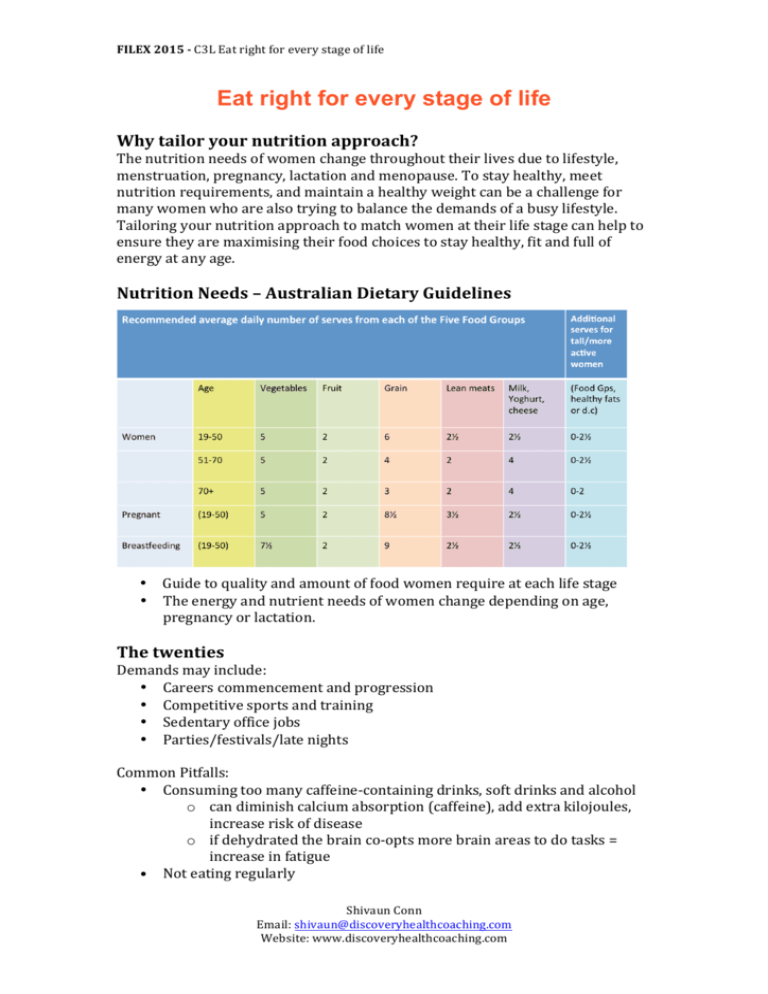
FILEX 2015 -­‐ C3L Eat right for every stage of life Eat right for every stage of life Why tailor your nutrition approach? The nutrition needs of women change throughout their lives due to lifestyle, menstruation, pregnancy, lactation and menopause. To stay healthy, meet nutrition requirements, and maintain a healthy weight can be a challenge for many women who are also trying to balance the demands of a busy lifestyle. Tailoring your nutrition approach to match women at their life stage can help to ensure they are maximising their food choices to stay healthy, fit and full of energy at any age. Nutrition Needs – Australian Dietary Guidelines • • Guide to quality and amount of food women require at each life stage The energy and nutrient needs of women change depending on age, pregnancy or lactation. The twenties Demands may include: • Careers commencement and progression • Competitive sports and training • Sedentary office jobs • Parties/festivals/late nights Common Pitfalls: • Consuming too many caffeine-­‐containing drinks, soft drinks and alcohol o can diminish calcium absorption (caffeine), add extra kilojoules, increase risk of disease o if dehydrated the brain co-­‐opts more brain areas to do tasks = increase in fatigue • Not eating regularly Shivaun Conn Email: shivaun@discoveryhealthcoaching.com Website: www.discoveryhealthcoaching.com FILEX 2015 -­‐ C3L Eat right for every stage of life • o affects blood sugar levels, mood and energy levels o reduces functioning of body and brain Cutting out necessary food groups for weight or ‘health’ reasons – common foods include grains, meat, and dairy. o Can deplete the brain of it’s primary source of fuel -­‐ carbohydrate o Can increase risk of nutrient deficiency o If cutting meat and dairy it potentially places women at risk of low iron and/or calcium. These two nutrients are in even greater need for women who are undergoing high levels of physical activity. Micronutrients for the 20’s – Iron • Iron is needed for: o Transportation of oxygen in the blood and muscles o The electron transport system -­‐ controls the release of energy from cells. o Red blood cell production and a healthy immune system • Women have higher iron requirements than men but… – generally take in less food overall – tend to be less inclined to regularly eat red meat Source: www.nrv.gov.au/nutrients/iron EAR (Estimated Average Requirement) -­‐ A daily nutrient level estimated to meet the requirements of half the healthy individuals in a particular life stage and gender group. RDI (Recommended Dietary Intake) -­‐The average daily dietary intake level that is sufficient to meet the nutrient requirements of nearly all (97–98 per cent) healthy individuals in a particular life stage and gender group. • • • • The large difference between the EAR and RDI for women is to do with the high variability in needs related to variability in menstrual losses It is assumed that women over 50 years do not menstruate. The lactation requirements are based on estimations that assume that menstruation does not resume until after 6 months of exclusive breastfeeding Dietary iron recommendations are 1.3 to 1.7 times higher for athletes than non-­‐athletes and 1.8 times higher for vegetarians than meat eaters Shivaun Conn Email: shivaun@discoveryhealthcoaching.com Website: www.discoveryhealthcoaching.com FILEX 2015 -­‐ C3L Eat right for every stage of life Risks for low iron • Restricted food intakes: • Trying to survive on low kilojoule intakes in an attempt to minimise body weight • Eating poorly balanced vegetarian diets • A high reliance on snack and convenience foods and failure to consume regular meals • Avoiding commercially fortified foods Risks for low iron -­‐ training • Hard training stimulates increase in red blood cell mass • Iron is lost in sweat • Blood loss through injury • Gastrointestinal bleeding during strenuous exercise due to minor damage to the stomach/intestinal lining • Mechanical trauma such as footstrike haemolysis can destroy red blood cells Effects of low iron on training • Low levels of iron in the tissues → Reduces oxygen uptake into the cells → Reduces performance capacity – particularly aerobic capacity • If untreated, iron depletion (even in the early stages) can quickly develop able to return to full training capacity. • If you suspect someone is at risk of low iron refer them to their GP for diagnosis and an APD for treatment Maintaining adequate levels of iron in the diet • Body unable to manufacture iron • Iron absorption best (15-­‐18%) from foods that contain haem iron • Iron absorption from foods that contain non-­‐haem iron is much lower (<5%) • Combine sources of haem iron with non-­‐haem iron • Vitamin C-­‐rich foods with meals enhances absorption of non-­‐haem iron • Excessive intakes of tea, coffee and unprocessed bran have an inhibitory effect on absorption Shivaun Conn Email: shivaun@discoveryhealthcoaching.com Website: www.discoveryhealthcoaching.com FILEX 2015 -­‐ C3L Eat right for every stage of life Micronutrients for the 20’s – Calcium • Needed for normal development and maintenance of the skeleton, neuromuscular and cardiac function. • Peak bone mass is reached around 25 to 30 years, when the skeleton has stopped growing and bones are at their strongest and thickest. • Adequate calcium consumption is necessary to develop and maintain strong bones that are resistant to fracture and osteoporosis in later life. Source: www.nrv.gov.au/nutrients/calcium Prevention of osteoporosis • Females are at higher risk than males • Female athletes are at higher risk of developing osteoporosis prematurely • Loss of periods (amenorrhea) due to hard training and low body fat levels result in the body producing less oestrogen which stops bones from reaching peak mass and strength Sources of calcium • Milk and milk-­‐based foods, with smaller amounts in bony fish, legumes and certain nuts, fortified soy beverages and breakfast cereals • Compared to milk, calcium absorption from dried beans is about 50% and from spinach, 10%. Shivaun Conn Email: shivaun@discoveryhealthcoaching.com Website: www.discoveryhealthcoaching.com FILEX 2015 -­‐ C3L Eat right for every stage of life Source: NUTTAB 2010 • • • Sodium intake can also affect calcium requirements as sodium and calcium excretion are linked in the kidney tubules. 2,300 mg of sodium takes out about 40 mg of calcium. Reduced fat milks are often slightly higher in calcium than regular-­‐fat milk because removing the fat increases the levels of the remaining nutrients. Some reduced-­‐fat milks may also have milk solids added which increase the calcium content, or they may have added calcium. Tofu -­‐ look for brands that contain calcium sulphate rather than nigari (magnesium chloride) Pre-­‐Pregnancy – Trying to Conceive (20’s, 30’s, 40’s) • • • • • The preconception period (three months prior to pregnancy) is the time to make life changes that can help boost fertility, reduce problems during pregnancy and assist in recovery from birth. Research has found that a healthy diet in the year prior to getting pregnant is also associated with a lower rate of birth defects Fertility will be best when close to 'ideal' body weight -­‐ not overweight or underweight o Research shows those who lose weight through exercise and a healthy diet before pregnancy have: § More regular ovulation § Increased pregnancy rates § Reduced miscarriage rates Folate is needed for healthy growth & development and can help prevent neural tube defects, such as spina bifida o Very difficult to get the folate needed through diet o Easiest and most effective way to raise folate levels -­‐ 0.5 mg folic acid supplement every day o Need to take extra folic acid for at least 1 month before pregnancy and for the first 3 months of the pregnancy o Foods that have the most folate include: § Green leafy vegetables -­‐ broccoli, spinach, salad greens § Chickpeas § Nuts § Orange juice § Dried beans, peas § Fortified foods -­‐ types of bread, breakfast cereals and other packaged foods o Heating can destroy folate. If you are cooking any folate-­‐rich vegetables it is best to microwave, stir-­‐fry or steam them. Although the evidence is not conclusive, research has found that high levels of caffeine consumption (above 500mg per day) may prolong the time it takes to get pregnant*. *Source: Anderson, K., Norman, R. J. et al. (2010). “Preconception lifestyle advice for people with subfertility.” Cochrane database of systematic reviews (4): CD008189. Shivaun Conn Email: shivaun@discoveryhealthcoaching.com Website: www.discoveryhealthcoaching.com FILEX 2015 -­‐ C3L Eat right for every stage of life Pregnancy -­‐ Nutrition Considerations* • • • • • • Extra nutritional demands on the body Increased needs for protein, iron, folate, iodine, zinc Increase grains to 8-­‐8.5 serves per day Healthy weight gain for healthy baby Minimise discomforts – nausea, vomiting, constipation Be risk aware – alcohol, caffeine, listeria, mercury *Source: www.eatforhealth.gov.au/sites/default/files/files/the_guidelines/n55h_healthy_eating_during_pregnancy.pdf Weight Gain • It is normal to gain weight during pregnancy -­‐ extra body tissue, placenta, fluid and blood as well as developing baby • Most women at a healthy weight can expect to gain 11-­‐16kg o Typical pattern of weight gain: § -­‐1-­‐1½ kg in the first 3 months § 1½-­‐2 kg per month for the rest of the pregnancy • If weight gain is in the healthy range it’s easier for women to return to pre-­‐ pregnancy weight • Gaining too much weight can increase risk of gestational diabetes and the baby’s risk of becoming overweight or developing metabolic syndrome later in life • The right amount of weight gain during pregnancy will depend on weight before pregnancy. Women who were already carrying extra weight should aim to gain less weight and underweight women may need to gain a little more weight. Institute of Medicine (2010) recommendations for total and rate of weight gain during pregnancy, by pre-­‐pregnancy BMI Source: www.eatforhealth.gov.au/eating-­‐well/healthy-­‐eating-­‐throughout-­‐all-­‐life/healthy-­‐eating-­‐when-­‐you’re-­‐ pregnant-­‐or-­‐breastfeeding Shivaun Conn Email: shivaun@discoveryhealthcoaching.com Website: www.discoveryhealthcoaching.com FILEX 2015 -­‐ C3L Eat right for every stage of life Minimise risks in foods and fluid • Alcohol -­‐ The safest choice is to drink none • Caffeine -­‐ It's best to limit caffeine-­‐containing drinks o High levels may make miscarriage more likely o Australian guidelines recommend less than 200 mg per day – 1-­‐2 instant coffees and two to three cups of tea • Listeria – bacteria passed on by contaminated food or poor food hygiene. The infection may be transferred to the baby and can lead to miscarriage, stillbirth or premature labour, or it can make a newborn baby very ill o Higher risk foods include cold meats, pre-­‐prepared salads, soft cheeses, chilled seafood, pate, soft serve • Mercury – a naturally occurring heavy metal can build up in some types of fish. Pregnant women need to be careful of the types and amounts of fish they eat as their baby is more at risk to the effects of mercury. Postnatal nutrition • • Extra nutrient needs and kilojoules to assist with breastfeeding and recovery after birth o Extra energy needs ~ 2000 kilojoules/day § Some will be met from body's existing fat stores § Other could come from healthy snacks Whilst breastfeeding avoid rapid weight loss or fad diets – can affect breast milk production, nutrients for baby and mother Source: www.eatforhealth.gov.au/sites/default/files/files/the_guidelines/n55g_adult_brochure.pdf Getting the body back into shape • Healthy foods that support breastfeeding energy and nutrient needs of breastfeeding • If not breastfeeding, energy needs will be decreased • Quick easy healthy meals and snacks Shivaun Conn Email: shivaun@discoveryhealthcoaching.com Website: www.discoveryhealthcoaching.com FILEX 2015 -­‐ C3L Eat right for every stage of life o Supply of healthy shelf stable foods – brown rice, wholemeal pasta, quinoa, freekah, pearl barley, legumes, tuna, salmon, sardines, baked beans, nuts, tinned tomatoes, tomato pasta sauces, natural popcorn, nut butters, wholegrain crackers o Supply of healthy frozen foods – fish, chicken, beef, lean mince, vegetarian mince (ie. quorn), pre-­‐packaged vegetables o Cook in bulk to reheat later – soups, casseroles, lasagne, bolognaise o Medium-­‐long lasting items – eggs, potatoes, sweet potatoes, onions, carrots, light pre-­‐packaged dips, some yoghurts and cheeses o Fruit and vegetable boxes delivery or online shopping o Healthy pre-­‐prepared meals or foods with accompanying recipes can be delivered Peri-­‐ & Post-­‐Menopause • • Perimenopause usually begins in a woman’s 40s but can begin as early as the mid-­‐30s. Menopause occurs one year after the last period, typically at age 51. Challenges -­‐ hormonal changes that lead to weight gain, loss of bone and muscle mass, and digestive issues, demanding work and family commitments, being time-­‐poor and the emergence of lifestyle diseases, including high insulin and cholesterol levels Weight • According to 2003-­‐2004 National Health and Nutrition Examination Survey (NHANES) data the largest percentage of women who become overweight or obese occurs between the ages of 40 and 59 (68.1%). • Research has shown that while changes in fat distribution can be attributed to hormonal shifts experienced by women in midlife, overall weight gain that occurs with age primarily is due to the effects of aging, such as decreased activity and a loss of lean body mass, which is more metabolically active than fat. • Energy density of food needs to be decreased whilst nutrient density is increased. o Increase vegetable content in meals and snacks § Keep fruit bowl visible at home and work § Carry fruit and vegetables as a snack § Cut up fruit and vegetables as snacks in fridge § Aim for ½ plate of vegetables – at least lunch and dinner o Boost calcium containing foods § Yoghurts § Milks (with adequate calcium if non-­‐dairy) § Cheese – is energy dense but calcium rich: 40g is 1 serve § Almonds § Figs § Tinned salmon with bones § Tofu – calcium set o Oily fish for vitamin D and omega 3 Shivaun Conn Email: shivaun@discoveryhealthcoaching.com Website: www.discoveryhealthcoaching.com FILEX 2015 -­‐ C3L Eat right for every stage of life o Portion control § Smaller plates and glasses § Refrigerate leftovers to prevent second helpings § Salads on table to pick at § Mindful eating o Minimise discretionary choices § Limit availability of discretionary foods in house, work § If discretionary foods must be in the house for others, shop for less desirable ones § Brainstorm distractions for when cravings occur or alternative rewards or stress relievers Minimising bone loss • Depletion of bone density often occurs after menopause when the ovaries stop producing estrogen • Women can lose as much as 20% of their bone density five to seven years after menopause • Best case scenario -­‐ enter menopause with sufficient bone density to minimize subsequent losses • Calcium, vitamin D, and adequate protein are key nutrition components to decreasing the amount of bone loss. Source: www.nrv.gov.au/nutrients/calcium Source:www.nrv.gov.au/nutrients/vitamin-d Sleep • Women in midlife can experience sleep disturbances as they transition to menopause. • According to the National Sleep Foundation, up to 61% of postmenopausal women report symptoms of insomnia, which include trouble falling or staying asleep for three or more nights per week for one month. • Decline in estrogen and progesterone leads to hot flushes in about 75% to 85% of women -­‐ contributes to insomnia • Most women experience hot flushes for about one year, but some experience them for up to five years. • Sleep loss can contribute to weight gain o Interrupts appetite regulation by elevating levels of the hunger hormone ghrelin and decreasing the satiety hormone leptin Gastrointestinal Changes Shivaun Conn Email: shivaun@discoveryhealthcoaching.com Website: www.discoveryhealthcoaching.com FILEX 2015 -­‐ C3L Eat right for every stage of life • • • Researchers believe it's the fluctuations in ovarian hormones that may contribute to GI distress -­‐ bowel discomfort, abdominal pain, bloating, altered bowel patterns Gut microbiota changes -­‐ decline in the number and variety of protective microbes Referral to an accredited practising dietitian – probiotics, low lactose, Low FODMAPS Recipe for healthy older years • Healthy younger years -­‐ protective • Choosing a diet rich in nutrients but lower in energy density with healthy fats & lean sources of protein • Including 3-­‐4 serves of calcium rich low-­‐fat dairy or dairy alternatives • Plenty of fruits and vegetables Keys to reducing energy density of food whilst boosting nutrient density • Increase vegetable content in meals and snacks o Keep fruit bowl visible at home and work o Carry fruit and vegetables as a snack o Cut up fruit and vegetables as snacks in fridge o Aim for ½ plate of vegetables – at least lunch and dinner • Boost calcium containing foods o Yoghurts o Milks (with adequate calcium if non-­‐dairy) o Cheese – is energy dense but calcium rich: 40g is 1 serve o Almonds o Figs o Tinned salmon with bones o Tofu – calcium set • Oily fish for vitamin D and omega 3 • Portion control o Smaller plates and glasses o Refrigerate leftovers to prevent second helpings o Salads on table to pick at o Mindful eating – eat with attention for noticing and enjoying food • Minimise discretionary choices o Limit availability of discretionary foods in house, work o If discretionary foods must be in the house for others, shop for less desirable ones o Brainstorm distractions for when cravings occur or alternative rewards or stress relievers o Grocery shop after eating a meal o Mindful eating – eat with the intention of caring for yourself and noticing the effects of food on your body “You only live once, but if you do it right, once is enough” -­‐MaeWest Shivaun Conn Email: shivaun@discoveryhealthcoaching.com Website: www.discoveryhealthcoaching.com


